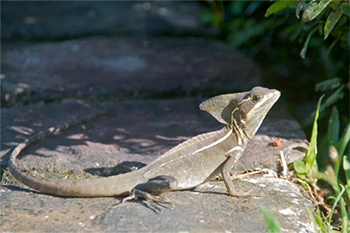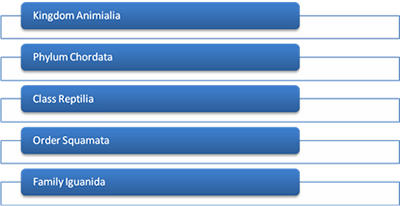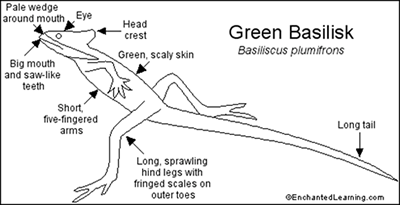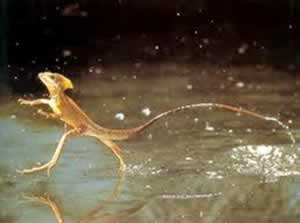Belize Reptile
Striped Basilisk (Basiliscus vittatus)

Overview: There are four species of basilisk: the common, the striped or brown basilisk, the red-head, and the green or plumed basilisk. This page is dedicated to the striped basilisk. AKA “Jesus Lizard” for its ability to run on water.
Home Range: South and Central Mexico, throughout Central America and into northwestern Columbia
Life Span: 4-7 years
Size: Adults can reach 1.5 to 2.5 feet in length. ~ one kilogram in weight. Female is generally smaller and less colorful.
Habitat: Near inland streams in a variety of forests, lowland dry to wet rainforest. Generally <800m elevation.
Behaviors: This lizard is active during the day. Commonly seen basking on sunny, hot rocks. Very territorial.
Reproduction: Female will dig a shallow trench in moist soil in which she will lay 12-18 eggs. After covering the eggs with soil, there is no more parental care. When the eggs hatch (after an incubation period of about 8 to 10 weeks), the young live in trees and eat insects that they catch themselves.
Taxonomic classification:

General Anatomy of Basiliscus

Although the diagram is of a Green Basilisk, the anatomy structure is shared in all genus of Basiliscus. In general, the tail of this organism constitutes for two-thirds of the body length. It can be used as a whip when threatened. Their mouths are capable of swallowing large prey for their size and have small serrated teeth used for gripping during food consumption. One characteristic apparent in all Basiliscus males is the head crest. This can aid in identification. Although each distinct species has its defining crest, the fact that each Basiliscus male has a crest makes this genus easier to separate from the true Iguana’s. The large, spread out nature of the hind feet enable this lizard to “walk on water” for a short amount of time when escaping danger. All Basiliscus are cold-blooded and require large amounts of time basking in the sun to warm their scaly skin structure.
Habitat Range
The striped basilisk is found naturally from South-Central Mexico to northern South America. Although not endemic to the region, pet trade has introduced the basilisk to the Florida Everglades. A permanent population of these reptiles has been established in the region. It is found in all sub tropical wet, dry and moist forests. Within these forest’s, the Basilisk can be found in close proximity to a stream or river. Preferring habitats that are both moist and have access to open sunlight for warming their cold-blooded circulatory system.
Reproduction
Both the male and female reach sexual maturity from four to 12 months of age. The striped basilisk breeds once a year and the female generally has anywhere from three to 12 hatched offspring. The gestation period lasts from 55 to 65 days. The female then lays the eggs in a hole, dug in the moist soil and covers them up. Eggs are laid in May to August and hatch in rainy season from June to September. The newly hatched basilisks are approximately two g and four cm long. They are born fully capable of climbing and eating. No parental care is given after the female covers up the eggs.
Diet and Behavior
These lizards are primarily insectivores. But because they also prey on fallen berries and fruit, the basilisks are considered to be an omnivore. Hanging near the water aids in the consumption of both aquatic insects and flying insects hatching near or on the water banks. Main diet consists of grasshoppers, scorpions, freshwater shrimp and small lizards or snakes. These animals utilize their tail for fat storage, which is common to all lizards.
The basilisk is a very apt at swimming, running and climbing. They are known to use their speed in order to escape predation, but if threatened, they will utilize their powerful tail to whip violently. These lizards can amazingly stay under water for 30 minutes when trying to escape terrestrial predators. Unfortunately this leaves them susceptible to aquatic predators. During the night hours, the basilisk either sleeps in suspended vine thickets or within the thick underbrush. In daylight hours, they will often be spotted on sunny rocks soaking up the heat to warm their bodies.
Unique Adaptation
 All species of the Basilisk have been documented running across the water. This adaptation has evolved as an effective mechanism for escaping predation. They are able to achieve this act by developing long toes on their hind feet with large scales to aid in surface area. This adaption is not seen in any other lizard within this region.
All species of the Basilisk have been documented running across the water. This adaptation has evolved as an effective mechanism for escaping predation. They are able to achieve this act by developing long toes on their hind feet with large scales to aid in surface area. This adaption is not seen in any other lizard within this region.
However, I found an interesting fact while researching the Basilisk. This lizard exhibits convergent evolution with an unrelated species from eastern India, called Hydrosaurus. This animal has been observed to run across the water when escaping predation just as the Basilisk. Therefore, this behavior is what ties them together in the concept of convergent evolution.
Ecological Background
Although the Basilisk is not threatened as an endangered species, increasing capture for pet trade has stressed these local populations in tropical ecosystems. As an adult, the Basilisk plays a role in keeping invertebrate and small rodent populations in check. While in juvenile stage, their die consists entirely of insects. The basilisk is also a major food staple for many tropical bird species and terrestrial mammals. The Basilisk has responded to the environmental stress of predation by evolving such a unique escape adaptation.
References
Please note that the following references may have either been removed or relocated by the webpage owners since the time this student report was created.
Anderson, Stephen. Basiliscus. The Green Basilisk. Web accessed May 29, 2012.
http://thepurewarrior.tripod.com/information/id1.html
Anonymous. Inriodulce. Did you see that? Basilisk (basiliscus vittatus). Web accessed May 29 2012.
http://www.inriodulce.com/links/basilisk.html
Enchanted Learning. Basilisk background. Article 2010. Web accessed May 29, 2012.
http://www.enchantedlearning.com/subjects/reptiles/lizard/Basilisk.shtml
Hsieh S. Three-dimensional hindlimb kinematics of water running in the plumed basilisk lizard (Basiliscus plumifrons). Journal of Experimental Biology. December 2003;206(23):4363-4377. Academic Search Complete, Ipswich, MA. Accessed May 30, 2012.
Nature’s Crusaders. Green basilisk lizards eat insects, rodents and runs on water. Article: Feb 16, 2009. Web accessed
May, 29 2012.
http://naturescrusaders.wordpress.com/2009/02/16/green-basilisk-lizards-eat-insects-rodents-and-runs-on-water/